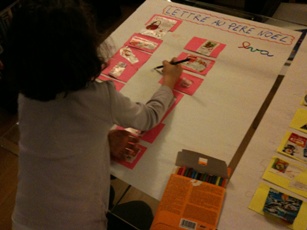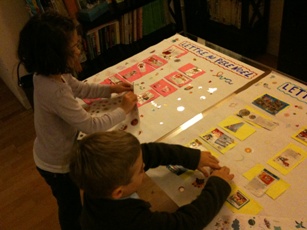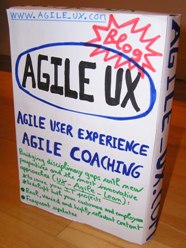Posted by jc-Qualitystreet on 2011/10/17
If France wins the world Cup next sunday, we’ll know why:)
The team handles the notes with dexterity, you can do IT!
So like them,
- live your RETROSPECTIVE with real agile values
- play Timeline
Thanks Jean-marc
And, ALLEZ LES BLEUS!!!
Posted by jc-Qualitystreet on 2011/02/21
… the team is now sprint#9, one week before the end of the release.
- All items of the Product Backlog are DONE (except the 5 user stories placed in the « to do » column of the current sprint. These stories are already delivered to internal testers)
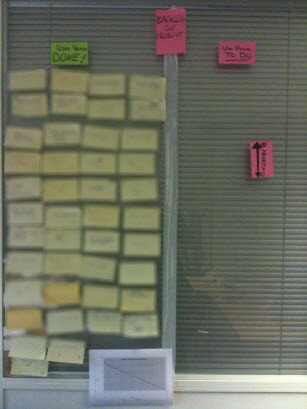
Product Backlog: no "To do" items remaining!
- Customer is delighted by the product he has received (incrementally). Very positive feedback sprint after sprint.
- Product quality is good: the application is fast, robust and secure
- Team satisfaction is high (best score)
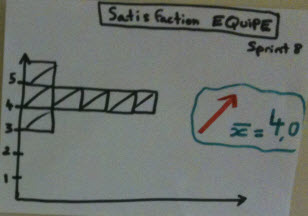
Team Satisfaction High : "I am glad I’am part of the team and satisfied with how our team works together"
- Trust and transparency are characteristics of the team
- Management satisfaction is high. managers plan to keep the team and to assign it a new product to work on
- Sprint burndown chart of the current sprint is good

A good Burndown Chart !
- Team velocity is good and steady since 4 or 5 sprints
- Team focus factor is high
- Team accuracy of estimation is good
- Action items of the previous action plan are done
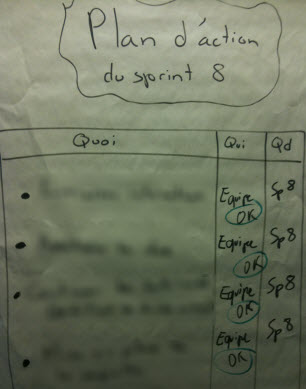
Actions items are tracked. Everything was done at the end of the sprint. The poster was displayed on the wall during the sprint.
- Just a few defects in the Bug tracking system
- No impediment
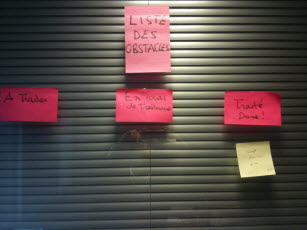
No impediment in the Impediments list
What else?
Just that it was a pleasure to coach such a good team! Thanks you guys.
Posted by jc-Qualitystreet on 2011/02/14
I usually say to Agile teams that the most important outcome of a sprint (or release) retrospective (but also important workshops), is the Action Plan.
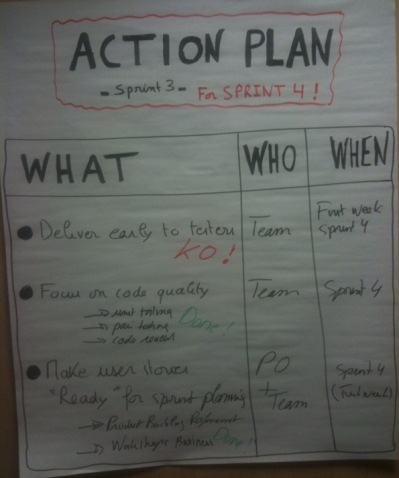
Scrum Retrospective Action Plan. A crucial element of facilitation.
Both past and future oriented, the SCRUM retrospective meeting aims to discover what the team did well, understand what went wrong, and to find ways to improve. It’s an important and intense exchange and communication event.
But completing an action plan, at the end of the retrospective, is the only way to make it fully successful and to engage the team in a continuous improvement approach (Inspect & Adapt) for better performance.
Simple
Concise and just enough…
Only a short list of actions (4 max) and three columns that make it simple and effective.
- What (the action: task-oriented, smart and with a verb)
- Who (the owner of the action)
- When (the agreed due-date)
Visual and visible
Build in collaboration on a large sheet of paper. At the end of the meeting, the action plan will join the team’s information radiator, into the team’s workplace to make it visible every day by everybody’s eyes. Communication is crucial for continuous improvement, and visual management is an effective strategy to make the follow up and to maintain engagement.
At the end of the next sprint, actions items of the previous plan will be reviewed: Done or KO…
SMART
Of course, the actions included in the « what » column are SMART:
- Specific
- Measurable
- Achievable
- Realistic
- Time-bound
Then, I like to get the team’s commitment to the plan before closing the meeting and doing the ROTI (Return On Time Invested).
Posted by jc-Qualitystreet on 2010/11/11
Or Agility at Home 🙂
Christmas is coming and for the third year we’ve done with kids, our letter to Santa Claus, or rather our prioritized Backlog for Santa Claus.
With Agile and Kaizen mindset, we seek to improve our process (see our 2009 process – English or our 2008 process – French)
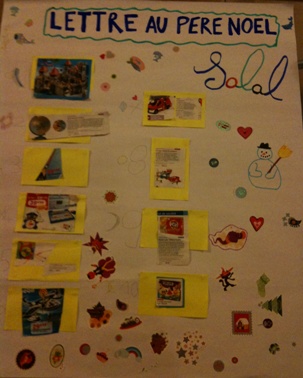
- A prioritized and customized backlog !
Same constraints as previous years
- Santa Claus is very busy
- His sledge is not expandable
- The deadlines are tight
- The delivery date cannot be moved
Other elements of context
My kids are now experienced Product Owners 🙂
- They handle sticky notes and patafix with dexterity…
- They know they cannot have everything (even if you always want more)…
- Being good (or not) has an impact on Santa Claus’s motivation to deliver what they wish…
SO , they realize they must prioritize their Christmas backlog !
How do we set priorities to write the letter to Santa Claus?
Step 1: Needs analysis, Brainstorming and data collection
Passionate reading for weeks, intensive research from several sources… confrontation with friends at school. « Workshop collaboration » with parents at home and, finally, cutting potential gifts
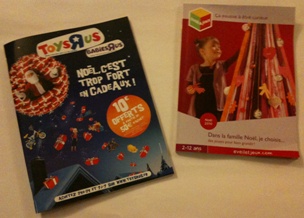
Catalogs...
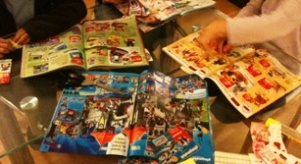
Brainstorming
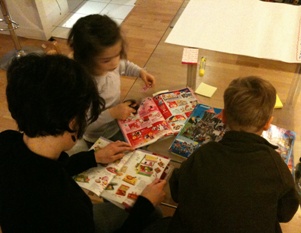
Collaborative workshop with parents
Step 2: Backlog Initialization
Images are cut. Place one image by sticky note (pink ones for my daughter; yellow notes for my son). Question of maturity: this year my son was able to participate actively (he is now 3 ½ years old). The two backlogs are initiated.
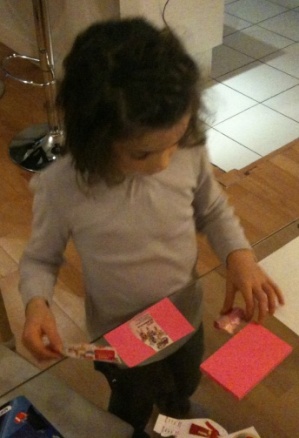
One image by Sticky note

Backlog item example
Step 3: Backlog Prioritization
Notes are laid on the ground. My kids make their prioritization effort and rank them in order of preference. They place on the top toys they want most, the most important to them…
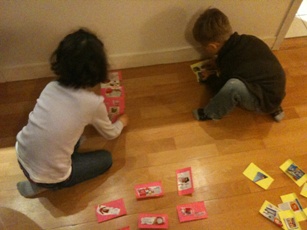
Prioritization effort

To set priorities: compare and use triangulation !
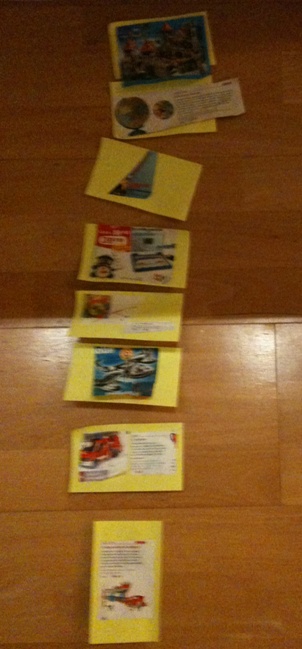
the list of items is prioritized
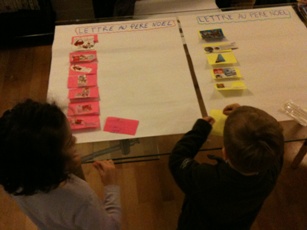
From the floor to the table
Step 4: Backlog Customization
Notes are now prioritized on the ground. We keep the principle of visual management but our product owner wish this year to customize their backlog.
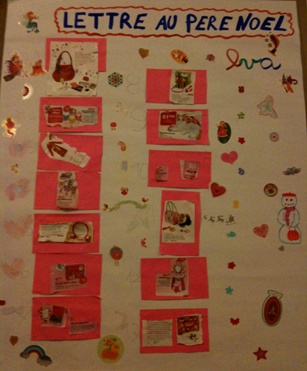
- Final Backlog – Girl version
Step 5 : Backlog display
Go to the room for an optimal visibility
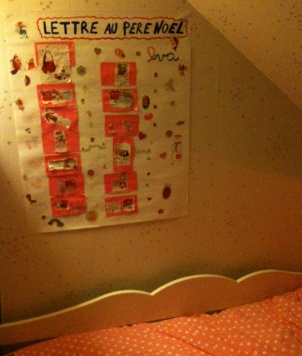
Visual management... In situ !
Results
We really had a great time and the children enjoyed it. They’re very very happy. And you know what ? … It was a pleasure to coach such good Product Owners 🙂
Posted by jc-Qualitystreet on 2010/08/11
One of the first differences observed with Agile is the way we estimate the size and duration of an IT project.
The entire team is made responsible for the estimate of the product Backlog (the list of all functionality desired in the product). Indeed, the team is invited to estimate collectively this list of valuable items that will require his work.
Scrum teams use Story Points and Planning Poker for this activity.
- Story Points represent a measurement of the effort required by a team to implement a Story.
- Planning Poker is an effective (and funny) way to assign collectively story points to user stories on the product backlog. It is a special card game based on the Fibonacci sequence. The idea is to pick a representative story and assign it a point value, then estimate the other stories relative to this standard (consensus must be reached for each user story)

Planning Poker Deck
Collective intelligence is the pillar of this new way to estimate … an effective team-based estimation technique but not so natural at first. Relative size and consensus are not so easy for the teams new to agile.
The problem:
Teams often lose the thread of their estimates. They have difficulty in comparing or lack of benchmarks.
An answer:
Use a visual display of the planning poker values in columns, and place the user stories in the appropriate column during the activity.
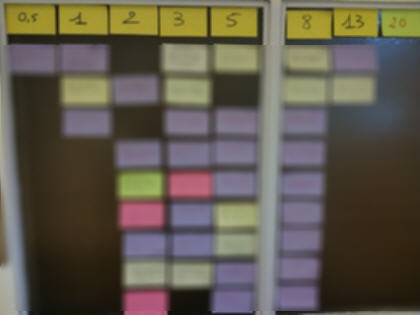
Visual display of the estimates
Benefits:
- It is an effective form of visual management
- It facilitates comparison and triangulation
- It reinforces the concept of relative size (effort)
- It reinforces the idea that result is not frozen during the activity: change is easy t!
















